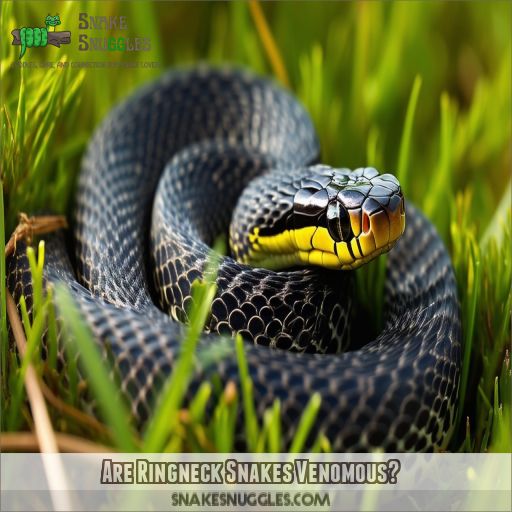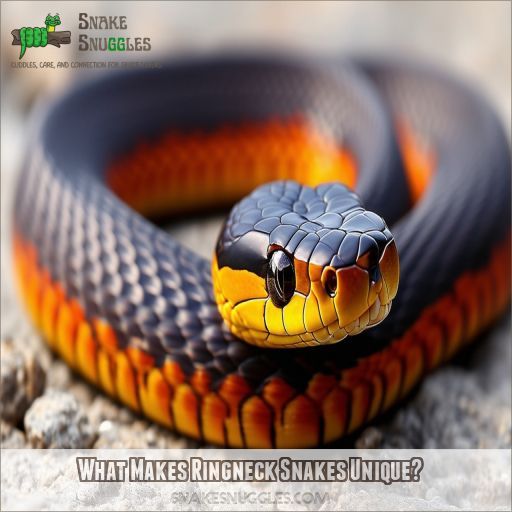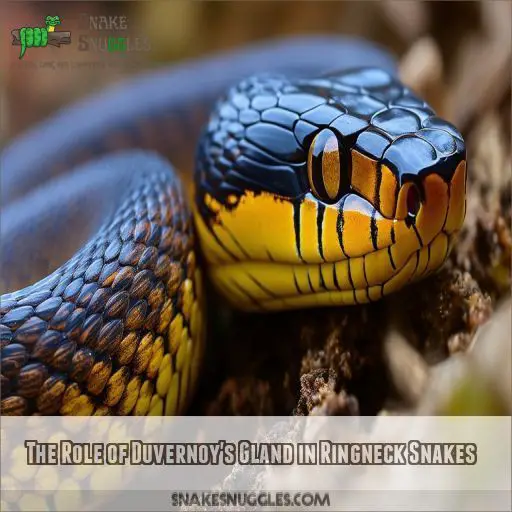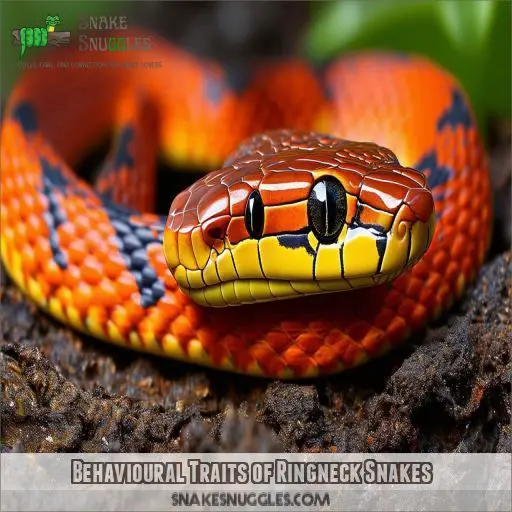This site is supported by our readers. We may earn a commission, at no cost to you, if you purchase through links.

Are ringneck snakes poisonous? The answer might surprise you. While they do possess a mild venom, it’s not harmful to humans. These shy creatures rarely bite and prefer to avoid confrontation.
In this article, we’ll explore the unique characteristics of ringneck snakes, their venom’s role, and why you needn’t fear encountering one in your backyard.
Table Of Contents
- Key Takeaways
- Are Ringneck Snakes Poisonous?
- Are Ringneck Snakes Venomous?
- What Makes Ringneck Snakes Unique?
- The Role of Duvernoy’s Gland in Ringneck Snakes
- Understanding Ringneck Snake’s Bite and Venom
- Behavioural Traits of Ringneck Snakes
- Frequently Asked Questions (FAQs)
- What happens when a ringneck snake bites you?
- Is it safe to pick up a ringneck snake?
- How aggressive are ringneck snakes?
- Why do I have ringneck snakes in my house?
- How long do ringneck snakes typically live?
- Can ringneck snakes be kept as pets legally?
- Do ringneck snakes hibernate during winter months?
- What are the natural predators of ringneck snakes?
- How fast can ringneck snakes move or slither?
- Conclusion
Key Takeaways
- Ringneck snakes are the Clark Kent of the reptile world – mild-mannered and harmless, despite packing a secret superpower (venom) that’s only kryptonite to tiny critters.
- These slithery ninjas are masters of hide-and-seek, preferring to curl up and play dead rather than pick a fight. Talk about conflict resolution skills!
- Your backyard might be a five-star hotel for these tiny travelers. They’re not there to crash your BBQ, just to keep the local bug population in check.
- If you stumble upon a ringneck snake, no need to run for the hills. These little guys are more likely to tie themselves in knots than take a bite out of you.
Are Ringneck Snakes Poisonous?
Are ringneck snakes poisonous? The short answer is no, but there’s a twist. These tiny reptiles are actually venomous, not poisonous. Don’t worry, though – their venom isn’t harmful to humans.
Ringnecks have rear-fanged choppers called opisthoglyphous teeth and special Duvernoy’s glands that produce just enough venom to subdue small prey like frogs and lizards. While they’re technically venomous, they pose no threat to you.
These shy, non-aggressive snakes prefer to avoid confrontation and rarely bite. Their striking appearance, with grayish bodies and bright neck rings, makes them unique among snakes.
There’s more to discover about these fascinating creatures.
Are Ringneck Snakes Venomous?
You might be surprised to learn that ringneck snakes are indeed venomous, but don’t panic! These tiny reptiles aren’t out to get you. They’re equipped with opisthoglyphous teeth, which are basically rear-fanged choppers that deliver a mild venom.
This venom isn’t designed for defense against larger creatures like us; it’s all about their diet. Ringnecks use their toxic saliva to subdue small prey like frogs and lizards. While it’s potent enough to paralyze their dinner, it’s harmless to humans.
Their venom glands, called Duvernoy’s glands, produce just enough toxin for their feeding needs. So, while technically venomous, ringnecks pose no threat to you.
Their docile nature and small size mean they’re more likely to curl up in fear than attempt a bite when encountering humans.
What Makes Ringneck Snakes Unique?
Ringneck snakes stand out due to their distinctive scale colors, unique habitat preferences, and interesting feeding behaviors. You’ll find these small reptiles have a striking appearance with their grayish bodies and bright neck rings, prefer moist woodland areas, and employ a combination of venom and partial constriction to subdue their prey.
Scale Colors and Patterns
You’ll be amazed by the striking appearance of ringneck snakes. These tiny colubrids boast a fascinating array of scale colors and patterns, making them truly unique. Here’s what makes them stand out:
- Grayish body with dorsal scales in black, tan, or blue
- Bright yellow or orange ring around the neck
- Smooth, glossy scales that catch the light
This visual adaptation helps them blend into their surroundings, showcasing nature’s incredible diversity in snake appearances.
Habitat Preference
You’ll find ringneck snakes across diverse landscapes, from Canada to Florida and the Pacific coast. They’re particularly abundant in Georgia and South Carolina.
These slender reptiles prefer wooded areas and moist habitats like floodplains and wetlands. Their microhabitat selection plays a pivotal ecological role, influencing prey availability and population density.
Despite their widespread geographic distribution, conservation efforts are essential to maintain their habitats and preserve their important place in local ecosystems.
Feeding Behavior
You’ll find ringneck snakes have fascinating feeding habits. These tiny reptiles primarily feast on small prey like frogs, lizards, and earthworms.
They’re not your typical constrictors; instead, they use a combination of mild venom from their Duvernoy’s glands and partial constriction to subdue their meals.
Surprisingly, they’ve even been known to take on larger prey like owls and skunks.
Their diet variation keeps pest populations in check.
The Role of Duvernoy’s Gland in Ringneck Snakes
Now that you’ve discovered what makes ringneck snakes unique, let’s explore the fascinating world of their venom production. You might be surprised to learn that these tiny reptiles possess a secret weapon: the Duvernoy’s gland. This specialized structure is responsible for toxin production in ringneck snakes, setting them apart from their non-venomous cousins.
Unlike traditional venom glands, the Duvernoy’s gland produces a mildly toxic saliva. This evolutionary adaptation plays a vital role in the snake’s hunting strategy. When a ringneck snake bites its prey, the toxins in its saliva cause paralysis, making it easier for the snake to subdue and consume its meal.
While the saliva toxicity is potent enough to immobilize small creatures, it’s generally harmless to humans. This unique feature of ringneck snakes showcases the incredible diversity in venom evolution among serpents.
Understanding Ringneck Snake’s Bite and Venom
You might be surprised to learn that ringneck snakes are mildly venomous, but their bite isn’t harmful to humans. Their venom, produced by Duvernoy’s glands, is primarily used to immobilize small prey like frogs and lizards, making it easier for the snake to subdue and consume its meal.
Effects of a Ringneck Snake Bite on Humans
While Duvernoy’s gland produces venom, you’ve got little to worry about from a ringneck snake bite. Bite symptoms are typically mild, including slight bleeding, swelling, and bruising.
The venom composition isn’t potent enough to harm humans. Treatment options are simple: clean the wound and monitor for rare allergic reactions.
These bites are uncommon, as ringnecks prefer to flee rather than fight.
How Venom Affects Prey
Ringneck snake venom isn’t harmful to humans, but it’s a different story for their prey.
The Duvernoy’s gland produces a toxic cocktail that paralyzes small animals. When ringneck snakes bite, they inject this venom, causing prey paralysis.
The venom’s composition is specifically designed for prey immobilization, allowing the snake to subdue and digest its meal efficiently.
It’s nature’s way of ensuring these tiny hunters can punch above their weight class.
Behavioural Traits of Ringneck Snakes
You’ll find that ringneck snakes aren’t aggressive towards humans and prefer to avoid confrontation. When threatened, they’ll coil up to display their bright underbelly and may release a musky odor as a deterrent, only resorting to biting as a last defense.
Defensive Mechanisms
When threatened, ringneck snakes employ a unique set of defensive mechanisms.
You’ll often see them coil up, displaying their vibrant underbelly as a warning. This defensive posturing is usually enough to deter predators.
If that doesn’t work, they’ll emit a foul-smelling musk from their cloaca.
Biting is their last resort, and it’s incredibly rare. Remember, while their bite can cause allergic reactions in some, it’s generally harmless to humans.
Interaction With Humans
Regarding human interactions, ringneck snakes prefer to escape rather than confront. You’ll seldom encounter them in nature as they’re shy and active at night.
If considering pet ownership, remember that captive care necessitates specific conditions.
Despite misconceptions about their danger, these snakes serve a vital ecological function.
Their conservation status is secure, but it’s best to admire them from a distance.
Frequently Asked Questions (FAQs)
What happens when a ringneck snake bites you?
You’ll feel a sting, but don’t panic. Ringneck bites are rare and mild. You’ll experience minor bleeding, swelling, and bruising. Clean the wound to prevent infection. Their venom isn’t harmful to humans, so you’ll be fine.
Is it safe to pick up a ringneck snake?
Yes, it’s generally safe to pick up a ringneck snake. They’re non-aggressive and rarely bite. However, handle them gently and wash your hands afterward. If you’re unsure about identification, it’s best to leave wild snakes alone.
How aggressive are ringneck snakes?
Ringneck snakes aren’t aggressive at all. You’ll find they’re shy and prefer to flee rather than fight. If cornered, they’ll coil up, show their colorful belly, and may release a musky odor to deter predators.
Why do I have ringneck snakes in my house?
Did you know 90% of ringneck snakes live near human dwellings? You’ve got these harmless houseguests because your home’s cool, damp, and full of tasty insects. They’re seeking shelter and food, not to cause trouble.
How long do ringneck snakes typically live?
You’ll find ringneck snakes typically live 6 to 10 years in the wild. With proper care, they can survive up to 20 years in captivity. Their lifespan depends on factors like habitat, diet, and predation risks.
Can ringneck snakes be kept as pets legally?
You can legally keep ringneck snakes as pets in many areas. They’re low-maintenance and docile, making them great for beginners. However, check local regulations and make sure you’re prepared to meet their specific care needs before bringing one home.
Do ringneck snakes hibernate during winter months?
You bet your bottom dollar, ringneck snakes do hibernate! They’ll curl up in cozy spots like rock crevices or logs during winter. You’ll find them emerging in spring, ready to bask in the sun and hunt.
What are the natural predators of ringneck snakes?
You’ll find that ringneck snakes face threats from various predators. Larger snakes, birds of prey, raccoons, and even domestic cats often hunt these small reptiles. Their vibrant neck rings don’t deter all hunters, unfortunately.
How fast can ringneck snakes move or slither?
Did you know ringneck snakes can reach speeds up to 3 mph? You’ll find these speedy serpents slithering swiftly through their habitats. They’re not Olympic sprinters, but they can certainly move quickly when they need to escape predators.
Conclusion
Like a gentle whisper in the garden, ringneck snakes embody nature’s harmless beauty. You now know that while these tiny reptiles are technically venomous, they’re not poisonous to humans. Their mild venom and shy nature make them fascinating, not fearsome, backyard neighbors.
Next time you spot a ringneck snake, you’ll know there’s no need for alarm.











